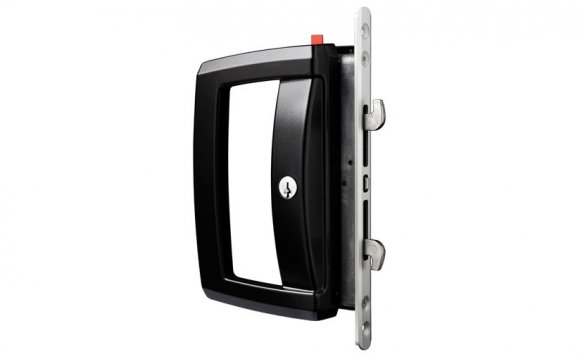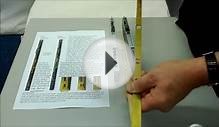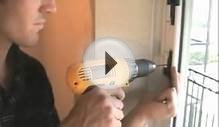
Both main parts of a mortise lock. Kept: the lock human body, installed in width of a door. This has two bolts: a sprung latch towards the top, and a locking bolt in the bottom. Appropriate: the container continue, put in into the doorjamb.
A mortise lock (mortice freeze Brit English) is a lock that needs a pocket—the mortise—to be cut in to the door or furniture piece into that your lock is usually to be fitted. Generally in most countries, mortise locks are found on older buildings constructed before the introduction of annoyed cylindrical locks, nonetheless they have recently are more typical in commercial and upmarket residential construction in the us. They are widely used in domestic properties of most centuries in European countries.
Mechanism[edit]
Mortise locks can include a non-locking sprung latch operated by a door handle. These types of a lock is called a sash lock. A simpler type without a handle or latch is termed a 'dead lock'. Dead locks are generally used as a protected backup to a sprung non-deadlocking latch, typically a pin tumbler rim lock.
Mortice hair have actually typically, and still generally do, utilize lever locks as a device. Older locks could have utilized warded locks. It has led to a favorite confusion between your two; the term 'mortice lock' is widely known and utilized, but frequently in reference to lever tips. Recently the Euro cylinder lock is now common, using a pin tumbler lock in a mortice housing.
The components contained in the typical United States mortise lock set up would be the lock body (the part installed inside the mortise cut-out in home); the lock trim (which might be chosen from any number of designs of doorknobs, levers, handle units and pulls); a strike dish, or a package continue, which lines the opening within the frame into that your bolt suits; and also the keyed cylinder which operates the locking/unlocking function of the lock human body. However, in the United Kingdom, and a lot of other nations, mortise locks on dwellings don't use cylinders, but have actually lever systems.
Installation[edit]
The installation of a mortise lock cannot generally speaking be done by the normal homeowner as it is labor-intensive and requires a functional understanding of standard woodworking tools and techniques. Numerous set up experts use a mortising jig helping to make precise cutting associated with pocket a simple operation, nevertheless the subsequent installation of the external trim can still prove problematic if installer is inexperienced.
Even though installing a mortise lock in fact weakens the structure of typical wood door, its more powerful and much more versatile than a bored cylindrical lock, both in additional trim, and functionality. Whereas the second system lacks the structure necessary for embellished and solid-cast knobs and levers, the mortise lock can accommodate a heavier return springtime and a more solid internal system, making its usage possible. In addition, a mortise lock usually takes a wide range of various other makers' cylinders and accessories, enabling architectural conformity with lock equipment already on site.
Some of the most typical makers of mortise locks in the usa tend to be correct, Arrow, Baldwin, ideal, Corbin Russwin, Emtek, Falcon, Penn, Schlage, Sargent and Yale Town & Lock. Additionally, many European makers whoever services and products was indeed limited to "designer" installations have recently gained wider acceptance and make use of.
Mortise lock standards[edit]
There are many different criteria for mortice hair being used. The most common are:
Brit Standard (little) Faceplate length: 152.5mm (6 ins) Backset:44.5mm (1¾ inches) C/C(lever lock): 57mm (2¼ inches). C/C(bathroom mortise lock): 57mm(2¼ inches). Utilized in interior doorways. British standard (big), BS3621 Faceplate size: 176mm (7 inches). Backset: 57mm (2¼ inches). C/C(lever lock): 57mm (2¼ ins). C/C(cylinder lock): 45mm (≈ 1¾ inches). Found in entry doors. Note: Many insurance plans require domiciles to put in a BS3621 lock because its 5 lever deadbolt is known to present increased protection. Us standard, ANSI A156.13, ML9000-series Faceplate length: 203mm (8 inches). Backset: 70mm (2¾ inches) . Used in entry doorways. Scandinavian standard (tiny), SS 817382, 20-series Faceplate size: 150mm. Backset: 45mm. C/C(lever lock): 72mm. C/C(bathroom mortise lock): 72mm. C/C(cylinder lock): 68mm. Found in inner doorways. Scandinavian standard (huge), SS 817383, Modular Lock Faceplate length: 225mm. Backset: 50mm. C/C(cylinder lock): 103.5mm/105mm. C/C(lever lock): 104mm found in entrance doorways. German standard, DIN 18 251 Faceplate length: 235mm. Backset: 55mm. C/C(lever lock): 72mm. C/C(cylinder lock): 72mm. C/C(bathroom mortise lock): 78mm. Used in entry doorways and interior doorways. Italian standard Faceplate length: 240mm. Backset: 35mm/40mm/50mm/55mm. C/C(lever lock): 92mm. C/C(cylinder lock): 85mm C/C(bathroom mortise lock): 92mm. Utilized in entrance doorways and interior doors. Older criteria These requirements are no longer in use in new doorways, but replacement hair are still being made. Norwegian standard (huge) Faceplate size: 210mm. Backset: 60mm(lever lock)/55mm(cylinder lock). C/C(lever lock): 72mm. C/C(cylinder lock): 95.5mm. C/C(bathroom mortise lock): 72mm. Norwegian standard (small), 22-series Faceplate length: 157mm. Backset: 55mm. C/C(lever lock): 72mm. C/C(bathroom mortise lock): 72mm. C/C(cylinder lock): 68mm. Swedish standard (small) Faceplate length: 215mm(earlier)/205mm(later). Backset: 45mm. C/C(lever lock): 72mm. Danish standard Faceplate length: 230mm. Backset: 57mm(lever lock)/60mm(cylinder lock). C/C(lever lock): 72mm. C/C(cylinder lock): 72mm.- The type generally called a 'Yale' lock.
References[edit]
RELATED VIDEO












